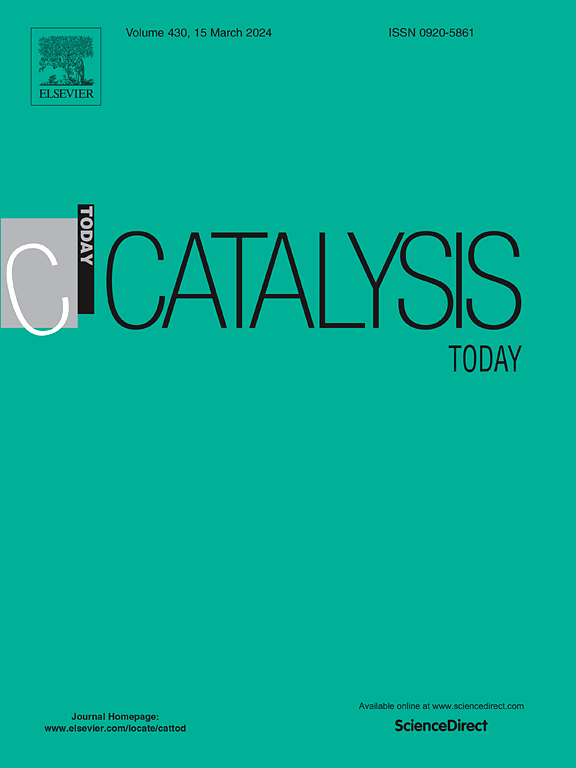A sustainable synthesis of a monometallic vanadium-supported H-beta zeolite catalyst for CO2-assisted oxidative dehydrogenation of butane to olefins
IF 5.2
2区 化学
Q1 CHEMISTRY, APPLIED
引用次数: 0
Abstract
Developing methods to utilize CO2 emissions is crucial for long-term environmental sustainability, as underground storage will eventually become impractical. One promising approach is the development of active catalysts for the CO2-assisted oxidative dehydrogenation of butane (CO2 ODHB) to olefins. This study presents the results of the performance of different vanadium loadings supported on H-beta Zeolite synthesized using the solvent-free approach for the CO2 ODHB. The catalysts were synthesized and characterized regarding surface morphology, surface reducibility, acidity, and textural properties using XRD, SEM-EDX, H2-TPR, NH3-TPD, and BET analysis. The H2-TPR result showed that the 10 wt%V/H-beta zeolite displayed higher reducibility and stronger metal-support interaction. The BET surface area increases with the percentage of vanadium oxide, except for the 5 % vanadium oxide content. The NH3 -TPD profile showed that as the loading of vanadium oxide increases on the surface of the zeolite support, the surface acidity of the catalyst increases from 2.5 wt%V/H-beta Zeolite to 10 wt%V/H-beta Zeolite and then drops at 15 wt%V/H-beta Zeolite. During a 10-hour time-on-stream test, the catalyst maintained stable butane conversion and C₄ olefin selectivity of approximately 31 % and 62 %, respectively, at 600 °C using a 10 wt%V/H-beta Zeolite catalyst. In-situ DRIFT measurements provided insights into the dynamic changes on the catalyst surface and the evolution of reaction intermediates during the CO2-assisted oxidative dehydrogenation of butane. The synthetic approach demonstrated a promising strategy for synthesizing an eco-friendly catalyst effective for CO2-assisted oxidative dehydrogenation of butane to olefins.
单金属钒负载h -沸石催化剂co2辅助丁烷氧化脱氢制烯烃的可持续合成
开发利用二氧化碳排放的方法对于长期的环境可持续性至关重要,因为地下储存最终将变得不切实际。一种很有前途的方法是开发用于CO2辅助氧化脱氢丁烷(CO2 ODHB)制烯烃的活性催化剂。研究了采用无溶剂法合成的h - β分子筛负载不同钒的性能。通过XRD、SEM-EDX、H2-TPR、NH3-TPD和BET分析对催化剂的表面形貌、表面还原性、酸度和结构性能进行了表征。H2-TPR结果表明,10 wt%V/ h - β分子筛具有较高的还原性和较强的金属-载体相互作用。除氧化钒含量为5 %外,BET表面积随氧化钒含量的增加而增加。NH3 -TPD谱图表明,随着载体表面氧化钒负载的增加,催化剂的表面酸度从2.5 wt%V/ h - β沸石增加到10 wt%V/ h - β沸石,然后下降到15 wt%V/ h - β沸石。在10小时的在线测试中,使用10 wt%V/ h - β沸石催化剂,在600°C下,催化剂的丁烷转化率和C₄烯烃选择性分别保持稳定,约为31% %和62% %。原位漂移测量提供了对催化剂表面的动态变化和反应中间体在co2辅助丁烷氧化脱氢过程中的演变的见解。该合成方法为丁烷氧化脱氢制烯烃提供了一种有效的环境友好型催化剂。
本文章由计算机程序翻译,如有差异,请以英文原文为准。
求助全文
约1分钟内获得全文
求助全文
来源期刊

Catalysis Today
化学-工程:化工
CiteScore
11.50
自引率
3.80%
发文量
573
审稿时长
2.9 months
期刊介绍:
Catalysis Today focuses on the rapid publication of original invited papers devoted to currently important topics in catalysis and related subjects. The journal only publishes special issues (Proposing a Catalysis Today Special Issue), each of which is supervised by Guest Editors who recruit individual papers and oversee the peer review process. Catalysis Today offers researchers in the field of catalysis in-depth overviews of topical issues.
Both fundamental and applied aspects of catalysis are covered. Subjects such as catalysis of immobilized organometallic and biocatalytic systems are welcome. Subjects related to catalysis such as experimental techniques, adsorption, process technology, synthesis, in situ characterization, computational, theoretical modeling, imaging and others are included if there is a clear relationship to catalysis.
 求助内容:
求助内容: 应助结果提醒方式:
应助结果提醒方式:


